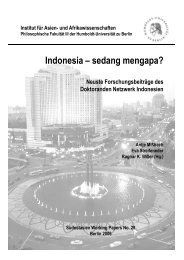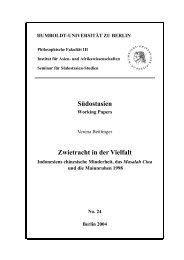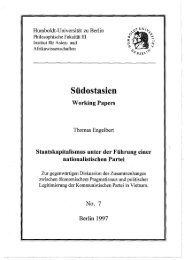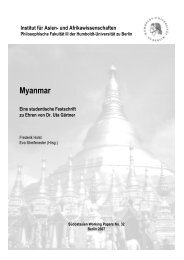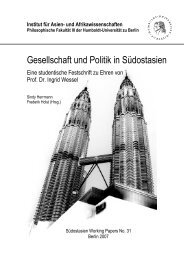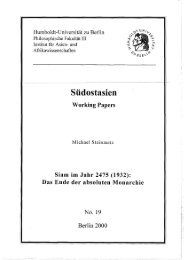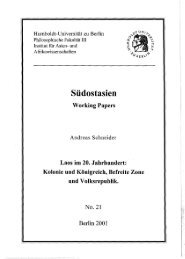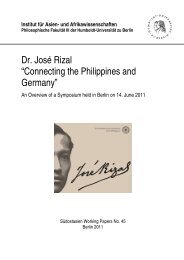On Centrism and Dualism - Humboldt-Universität zu Berlin
On Centrism and Dualism - Humboldt-Universität zu Berlin
On Centrism and Dualism - Humboldt-Universität zu Berlin
Create successful ePaper yourself
Turn your PDF publications into a flip-book with our unique Google optimized e-Paper software.
CENTRISM AND DUALISM<br />
concept represents the means to unify elements of analytical categories to prove their<br />
relationship <strong>and</strong> thus their comparability. Her overall conclusion is that everything seems to<br />
be a transformation of everything in isl<strong>and</strong> Southeast Asia. In the course of her argument<br />
ERRINGTON identifies marriage systems, siblingship, <strong>and</strong> houses as the primary contexts of<br />
comparison. This choice of contexts, together with her emphasis on transformation as a<br />
heuristic devise, proves the ‘structuralist’ influence that characterizes her work. 19 The<br />
essential paradigms of her ‘structuralist’ background will be discussed in the following<br />
chapter.<br />
II.1.1.1.<br />
Theoretical Starting Points<br />
Structure can be defined as the internal relationship through which constituent elements of a whole<br />
are organized. Structural analysis thus consists of the discovery of significant elements <strong>and</strong> their<br />
order. (MARANDA/MARANDA 1971: 16)<br />
In his survey of structural anthropology, Michael OPPITZ (1975) gives a principle definition of<br />
the concept of structure, which he perceives as the totality of elements related in such a way<br />
that the modification of one element or one relation brings about a modification of the other<br />
elements or relations. This definition is based on the concept of totality, which includes the<br />
idea of interdependence between its constitutive elements (ibid.: 19), implying at the same<br />
time that the whole is more than the sum of its parts.<br />
OPPITZ claims that LÉVI-STRAUSS’ conception of transformation was derived from the work<br />
of the British biologist D’Arcy Wentworth THOMPSON. 20 Inspired by the THOMPSON’S ideas,<br />
LÉVI-STRAUSS coupled the concept of transformation with that of structure, with this<br />
relationship becoming an essential aspect of his structuralism (ibid.: 215). 21<br />
Now the notion of transformation is inherent in structural analysis. I would even say that all errors,<br />
all the abuses committed through the notion of structure are a result of the fact that their authors<br />
have not understood that it is impossible to conceive of structure separate from the notion of<br />
transformation (LÉVI-STRAUSS 1994: 427 [1991: 113]).<br />
19 In addition to these ‘structuralist’ concepts, ERRINGTON’S study is deeply influenced by the work <strong>and</strong> ideas of<br />
Clifford GEERTZ <strong>and</strong> Benedict ANDERSON. Their impact becomes especially apparent in ERRINGTON’S idea of<br />
the ‘Indic State’, which in many aspects resembles GEERTZ’S discussion of the Balinese polity (cf. GEERTZ<br />
1980) <strong>and</strong> directly derived from ANDERSON’S study of the Javanese conception of ‘power’ (cf. ANDERSON 1972:<br />
3). A second major influence is GEERTZ’S interpretative paradigm <strong>and</strong> his concept of ‘thick description’ as<br />
identified by James FOX (Fox 1991: 988). Nevertheless, her explicit sympathy for ‘structuralist’ ideas makes her<br />
study “a fairly non-dogmatic example of the “interpretation of meaning” school of anthropology (BABCOCK<br />
1991: 135)”, which is in itself at times equated with postmodernist anthropology (cf. BOROFSKY 1994: 25).<br />
20 This is, in fact, acknowledged by LÉVI-STRAUSS himself, who states that Wentworth THOMPSON’S<br />
interpretation of the visible differences between species as transformations was an illumination for him that<br />
deeply affected his conception of structure (cf. LÉVI-STRAUSS 1994: 427 [1991: 113].<br />
21 “A very close relationship exists between the concept of transformation <strong>and</strong> that of structure, which occupies<br />
such a large place in our work (LÉVI-STRAUSS 1976a: 18).”<br />
14



